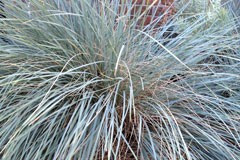
Deschampsia caespitosa
Evergreen mounding grass with delightful seedheads in autumn, will not self seed like many native grasses do. Lovely with sedums and miscanthus.


'Blue oat grass', European representative from the poaceae family, evergreen grass with attractive blue tinge and vertical foliage. Its primary advantage is that it doesnt self sow like its native counterparts, making it much easier to manage in mixed perennial plantings.
'Blue oat grass', European representative from the poaceae family, evergreen grass with attractive blue tinge and vertical foliage. Its primary advantage is that it doesnt self sow like its native counterparts, making it much easier to manage in mixed perennial plantings.
Data sheet
Evergreen mounding grass with delightful seedheads in autumn, will not self seed like many native grasses do. Lovely with sedums and miscanthus.
A beautiful variety with silver and reddish flower heads that stand well above the foliage and last into winter. Like other varieties, cut down to ground level in winter every few years.
Division grown cultivar with better autumn colour than the species, bad name for a good plant. Vertical foliage to waist high and attractive flower heads in late summer.
Attractive long flowering ornamental grass which flowers in summer with miscanthus, sedums, agastache, and echinacea. Very easy and well behaved in clay however in light sandy soils may be overly vigorous and only suit the large garden. We have found only occasional seedlings, but as with all grasses, deadhead if seeding occurs. Useful for foreground in...
An attractive silver-leafed species with recurved leaves, lower growing than the more vertical A. chathamica.
Evergreen plant from the iris family often used for mass planting. White flowers and strappy foliage, native of South Africa. Tough and easy but not for wet and heavy soil.
A graceful low mounding grass from Japan, best in shade and good soil. Useful for foliage effect amongst other woodland plants. This is the green foliage form, deciduous in winter.
One our favourite new grasses, waist high flowers with rich green foliage, creating good mounding fill and texture within summer perennial plantings. Grows best on heavier fertile soils, and responds well to moisture in summer if available, but not overly demanding.
Grey blue low growing grass with weeping foliage, used for landscaping applications in mass plantings, edgings, or combined with euphobias, westringia and sedums.
A versatile rush from South Africa that will grow in a surprising range of conditions. The tall foliage is particularly good all year round, and the new growth resembles bamboo. Good for structure amongst herbaceous plants.
A brilliant low grass with outstanding flowers and seedheads, suitable for massed foreground plantings in landscape design work or in clusters amongst other perennials. A slender plant so plant closely at 25cm for best results. Not self seeding in our trial stockbeds.
Lower growing to waist high with soft foliage and improved autumn colour, one of the better panicums. A nicely clumping contained grass that looks good in groups amongst echinacea and summer perennials, wont self seed and lasts a long time. However needs decent fertile soil to flourish.
Tall growing ornamental grass, with attractive dark green foliage and feathery seedheads in summer.
Gracefully weeping evergreen grass colouring bronze and silver in autumn. Useful as foreground to more upright varieties like Miscanthus "Sarabande" and Calamagrostis "Karl Forester".
Perennial temperate grass with bamboo like foliage, wider bladed than miscanthus and more stout and rounded in form. Valuable for landscaping and mass planting. Native to Northern China, Manchura and Siberia, prefers a cooler position.
Alpine tussock found in Tasmanian alpine areas. It does surprisingly well in most garden conditions providing it is well drained.

'Blue oat grass', European representative from the poaceae family, evergreen grass with attractive blue tinge and vertical foliage. Its primary advantage is that it doesnt self sow like its native counterparts, making it much easier to manage in mixed perennial plantings.